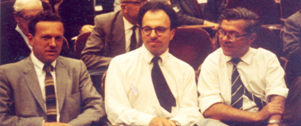- 1610: Galileo
- 1676: Ole Rømer
- 1687: Isaac Newton
- 1781: William Herschel
- 1838: Friedrich Bessel
- 1861: William and Margaret Huggins
- 1912: Henrietta Leavitt
- 1917 Einstein
- 1920: Harlow Shapley
- 1929 Edwin Hubble
- 1948: Ralph Alpher
- 1949: Fred Hoyle
- 1963: Maarten Schmidt
- 1964: Arno Penzias and Robert Wilson
- 1978: Vera Rubin and Kent Ford
- 1989: Margaret Geller and John Huchra
- 1992: John Mather and George Smoot
- 1995: Robert Williams
- 1998: Saul Perlmutter and Brian Schmidt
- 2010: Wendy Freedman
Gold, Bondi, and Hoyle
 |
| Image of Gold, Bondi and Hoyle at a conference. By permission of the Master and Fellows of St John's College, Cambridge. |
Hoyle met Bondi and Gold in 1942, when he was assigned to a radar station erected to warn of bombing attacks on London. Over the years the three spent many evenings discussing physics together. Like Einstein, they were unhappy with the idea implied by Hubble’s observations that the universe is expanding. They came up with the Steady State theory one evening after watching a movie together.
Since they could not argue effectively with the evidence provided by Hubble’s observations, the puzzle they had to solve was to explain how the universe could be expanding, while still staying the same. The movie they saw together was a British horror film called Dead of Night. The central character of the story wakes up from a nightmare only to find that the experiences from his dream are real. In the midst of the mayhem, he wakes up relieved to find that it was all a dream. Later in the day the experiences from the dream start to happen again in real life. In other words, the story evolves over time, but ends up exactly where it started. Many modern movies, such as the comedy “Groundhog Day” have since been written with this general structure.
Tommy Gold’s idea, inspired by the movie, was that as the universe expanded new matter was created in the widening gaps between the galaxies. The idea that the universe is always changing yet remains the same is called dynamic equilibrium. Although the theory does not explain how matter could be created from nothing, the same criticism could be leveled at the Big Bang theory. Gold and Bondi published the theory in broad terms in 1949. Hoyle published a mathematical account of the theory later the same year.
The two competing theories were now established: The Big Bang theory predicted that the universe is expanding from a single point and that the remnants of the Big Bang could be observed in the form of microwaves. The Steady State theory proposed that although the universe is expanding, new matter is always being created so that the average density of matter in the universe does not change. The rate of matter creation needed ( ~ 10^-9 atoms m^-3 yr^-1) was very small and could not be ruled out experimentally. The Steady State theory predicted that no microwave signal would be observed. But neither theory was perfect.